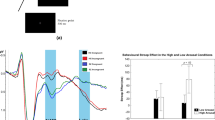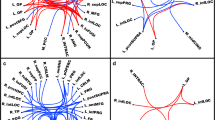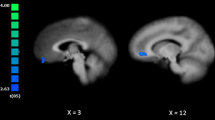Abstract
We hypothesize that decreased temporal variability of emotional network connectivities, corresponding to a continual state of hyperactivity, may play a role in mediating symptoms in schizophrenia. Resting-state magnetic resonance data were collected from 64 subjects, including 21 positive symptom profile schizophrenia patients (PSZ group), 19 negative symptom profile schizophrenia patients (NSZ group), and 24 healthy controls. The emotional brain network was defined based on the coordinates obtained from multi-level kernel density analysis. The temporal variability of intra-network functional connectivities (FCs) was calculated by constructing networks from blood oxygen level-dependent signals at successive, non-overlapping time windows, and was compared between groups. The results showed that the mean FC-variability of the whole emotional network (P = 0.021), and the FC-variabilities in the bilateral anterior insula (both, P < 0.001) were significantly decreased in the PSZ group compared with the control and NSZ groups. Abnormally enhanced negative coupling between variability and FC strength (V-S coupling) was observed in the PSZ group (P = 0.027). In summary, this study found a relation between the positive symptoms of schizophrenia and decreased variability of emotional network connectivities. These findings may help us better understand the neurobiological effect of the time-varying properties of the brain network in schizophrenia patients, and the underlying relation to the generation of psychosis.



Similar content being viewed by others
References
Adolfi, F., Couto, B., Richter, F., Decety, J., Lopez, J., Sigman, M., et al. (2017). Convergence of interoception, emotion, and social cognition: a twofold fMRI meta-analysis and lesion approach. Cortex, 88124–88142.
Barkhof, E., de Sonneville, L. M., Meijer, C. J., & de Haan, L. (2015). Processing of facial and nonsocial information is differentially associated with severity of symptoms in patients with multiepisode schizophrenia. The Journal of Nervous and Mental Disease, 203(2), 112–119.
Blair, R. J. (2016). The neurobiology of impulsive aggression. Journal of Child and Adolescent Psychopharmacology, 26(1), 4–9.
Blanchard, J. J., & Cohen, A. S. (2006). The structure of negative symptoms within schizophrenia: implications for assessment. Schizophrenia Bulletin, 32(2), 238–245.
Calhoun, V. D., Miller, R., Pearlson, G., & Adali, T. (2014). The chronnectome: time-varying connectivity networks as the next frontier in fMRI data discovery. Neuron, 84(2), 262–274.
Chen, H., Liu, K., Zhang, B., Zhang, J., Xue, X., Lin, Y., et al. (2019). More optimal but less regulated dorsal and ventral visual networks in patients with major depressive disorder. Journal of Psychiatric Research, 110, 172–178.
Deng, Y., Liu, K., Cheng, D., Zhang, J., Chen, H., Chen, B., et al. (2019). Ventral and dorsal visual pathways exhibit abnormalities of static and dynamic connectivities, respectively, in patients with schizophrenia. Schizophrenia Research, 206103–206110.
Du, Y., Pearlson, G. D., Lin, D., Sui, J., Chen, J., Salman, M., et al. (2017). Identifying dynamic functional connectivity biomarkers using GIG-ICA: application to schizophrenia, schizoaffective disorder, and psychotic bipolar disorder. Human Brain Mapping, 38(5), 2683–2708.
Grace, A. A. (2012). Dopamine system dysregulation by the hippocampus: implications for the pathophysiology and treatment of schizophrenia. Neuropharmacology, 62(3), 1342–1348.
Gu, X., Hof, P. R., Friston, K. J., & Fan, J. (2013). Anterior insular cortex and emotional awareness. The Journal of Comparative Neurology, 521(15), 3371–3388.
Hall, J., Harris, J. M., Sprengelmeyer, R., Sprengelmeyer, A., Young, A. W., Santos, I. M., et al. (2004). Social cognition and face processing in schizophrenia. The British Journal of Psychiatry, 185169–185170.
Hooker, C., & Park, S. (2002). Emotion processing and its relationship to social functioning in schizophrenia patients. Psychiatry Research, 112(1), 41–50.
Horan, W. P., Blanchard, J. J., Clark, L. A., & Green, M. F. (2008). Affective traits in schizophrenia and schizotypy. Schizophrenia Bulletin, 34(5), 856–874.
Hutchison, R. M., Womelsdorf, T., Gati, J. S., Everling, S., & Menon, R. S. (2013). Resting-state networks show dynamic functional connectivity in awake humans and anesthetized macaques. Human Brain Mapping, 34(9), 2154–2177.
Jin, C., Jia, H., Lanka, P., Rangaprakash, D., Li, L., Liu, T., Hu, X., & Deshpande, G. (2017). Dynamic brain connectivity is a better predictor of PTSD than static connectivity. Human Brain Mapping, 38(9), 4479–4496.
Joo, Y. H., Kim, J. H., Son, Y. D., Kim, H. K., Shin, Y. J., Lee, S. Y., & Kim, J. H. (2018). The relationship between excitement symptom severity and extrastriatal dopamine D2/3 receptor availability in patients with schizophrenia: a high-resolution PET study with [(18)F]fallypride. European Archives of Psychiatry and Clinical Neuroscience, 268(6), 529–540.
Kay, S. R., Fiszbein, A., & Opler, L. A. (1987). The positive and negative syndrome scale (PANSS) for schizophrenia. Schizophrenia Bulletin, 13(2), 261–276.
Kohler, C. G., Bilker, W., Hagendoorn, M., Gur, R. E., & Gur, R. C. (2000). Emotion recognition deficit in schizophrenia: association with symptomatology and cognition. Biological Psychiatry, 48(2), 127–136.
Kohler, C. G., Walker, J. B., Martin, E. A., Healey, K. M., & Moberg, P. J. (2010). Facial emotion perception in schizophrenia: a meta-analytic review. Schizophrenia Bulletin, 36(5), 1009–1019.
Lee, S. H., Niznikiewicz, M., Asami, T., Otsuka, T., Salisbury, D. F., Shenton, M. E., et al. (2016). Initial and progressive gray matter abnormalities in insular Gyrus and temporal pole in first-episode schizophrenia contrasted with first-episode affective psychosis. Schizophrenia Bulletin, 42(3), 790–801.
Li, T., Wang, Q., Zhang, J., Rolls, E. T., Yang, W., Palaniyappan, L., Zhang, L., Cheng, W., Yao, Y., Liu, Z., Gong, X., Luo, Q., Tang, Y., Crow, T. J., Broome, M. R., Xu, K., Li, C., Wang, J., Liu, Z., Lu, G., Wang, F., & Feng, J. (2017). Brain-wide analysis of functional connectivity in first-episode and chronic stages of schizophrenia. Schizophrenia Bulletin, 43(2), 436–448. https://doi.org/10.1093/schbul/sbw099.
Liao, X., Yuan, L., Zhao, T., Dai, Z., Shu, N., Xia, M., et al. (2015). Spontaneous functional network dynamics and associated structural substrates in the human brain. Frontiers in Human Neuroscience, 9, 478.
Liu, K., Zhao, X., Lu, X., Zhu, X., Chen, H., Wang, M., et al. (2018). Effect of selective serotonin reuptake inhibitor on prefrontal-striatal connectivity is dependent on the level of TNF-alpha in patients with major depressive disorder. Psychological Medicine, 1–9.
Milev, P., Ho, B. C., Arndt, S., & Andreasen, N. C. (2005). Predictive values of neurocognition and negative symptoms on functional outcome in schizophrenia: a longitudinal first-episode study with 7-year follow-up. The American Journal of Psychiatry, 162(3), 495–506.
Pang, L., Kennedy, D., Wei, Q., Lv, L., Gao, J., Li, H., et al. (2017). Decreased functional connectivity of insular cortex in drug naive first episode schizophrenia: In relation to symptom severity. PLoS One, 12(1), e167242.
Power, J. D., Mitra, A., Laumann, T. O., Snyder, A. Z., Schlaggar, B. L., & Petersen, S. E. (2014). Methods to detect, characterize, and remove motion artifact in resting state fMRI. Neuroimage, 84320–84341.
Salvador, R., Sarro, S., Gomar, J. J., Ortiz-Gil, J., Vila, F., Capdevila, A., et al. (2010). Overall brain connectivity maps show cortico-subcortical abnormalities in schizophrenia. Human Brain Mapping, 31(12), 2003–2014.
Scholvinck, M. L., Maier, A., Ye, F. Q., Duyn, J. H., & Leopold, D. A. (2010). Neural basis of global resting-state fMRI activity. Proceedings of the National Academy of Sciences of the United States of America, 107(22), 10238–10243.
Vai, B., Sferrazza, P. G., Poletti, S., Radaelli, D., Donnici, E., Bollettini, I., et al. (2015). Abnormal cortico-limbic connectivity during emotional processing correlates with symptom severity in schizophrenia. European Psychiatry, 30(5), 590–597.
Weniger, G., Lange, C., Ruther, E., & Irle, E. (2004). Differential impairments of facial affect recognition in schizophrenia subtypes and major depression. Psychiatry Research, 128(2), 135–146.
Wong, C. W., Olafsson, V., Tal, O., & Liu, T. T. (2013). The amplitude of the resting-state fMRI global signal is related to EEG vigilance measures. Neuroimage, 83, 983–990.
Zalesky, A., Fornito, A., Cocchi, L., Gollo, L. L., & Breakspear, M. (2014). Time-resolved resting-state brain networks. Proceedings of the National Academy of Sciences of the United States of America, 111(28), 10341–10346.
Zeng, L. L., Wang, D., Fox, M. D., Sabuncu, M., Hu, D., Ge, M., et al. (2014). Neurobiological basis of head motion in brain imaging. Proceedings of the National Academy of Sciences of the United States of America, 111(16), 6058–6062.
Zhang, J., Kendrick, K. M., Lu, G., & Feng, J. (2015a). The fault lies on the other side: altered brain functional connectivity in psychiatric disorders is mainly caused by counterpart regions in the opposite hemisphere. Cerebral Cortex, 25(10), 3475–3486. https://doi.org/10.1093/cercor/bhu173.
Zhang, R., Wei, Q., Kang, Z., Zalesky, A., Li, M., Xu, Y., et al. (2015b). Disrupted brain anatomical connectivity in medication-naive patients with first-episode schizophrenia. Brain Structure & Function, 220(2), 1145–1159. https://doi.org/10.1093/cercor/bhu173.
Zhang, J., Cheng, W., Liu, Z., Zhang, K., Lei, X., Yao, Y., et al. (2016). Neural, electrophysiological and anatomical basis of brain-network variability and its characteristic changes in mental disorders. Brain, 139(Pt 8), 2307–2321.
Funding
The study was supported by the grants from the National Natural Science Foundation of China (No. 81801682, No. 81701674, and No. 31640028), and also supported by the grant from Guangdong Natural Science Foundation (No. 2018030310296).
Author information
Authors and Affiliations
Contributions
Conception and study design (Yanjia Deng, Kai Liu, and Ge Wen). Data collection and acquisition (Dongliang Chen, Ge Wen, and Yingjia Li). Imaging data and statistical analyses (Kai Liu, Shuguang Han, and Youyong Kong). Assessment of the clinical data (Yong Lin and Bin Zhang). Drafting the manuscript (Yanjia Deng and Kai Liu). Revising the manuscript (Shuguang Han, Hui Li, and Bin Zhang). Approval of final version to be published and agreement to be accountable for the integrity and accuracy of all aspects of the work (All authors).
Corresponding authors
Ethics declarations
Conflict of interest
The authors declare no competing financial interests.
All procedures performed in studies involving human participants were in accordance with the ethical standards of the institutional ethical committee and with the 1964 Helsinki Declaration and its later amendments or comparable ethical standards.
Additional information
Publisher’s note
Springer Nature remains neutral with regard to jurisdictional claims in published maps and institutional affiliations.
Electronic supplementary material
ESM 1
(DOCX 26 kb)
Rights and permissions
About this article
Cite this article
Deng, Y., Han, S., Cheng, D. et al. Simultaneously decreased temporal variability and enhanced variability-strength coupling of emotional network connectivities are related to positive symptoms in patients with schizophrenia. Brain Imaging and Behavior 15, 76–84 (2021). https://doi.org/10.1007/s11682-019-00234-0
Published:
Issue Date:
DOI: https://doi.org/10.1007/s11682-019-00234-0




